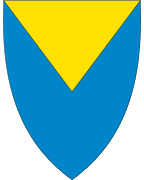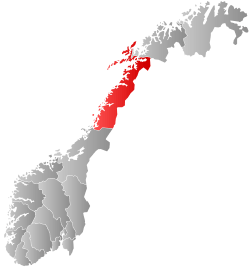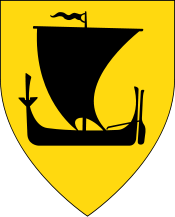Nesna
| Nesna kommune | |||
|---|---|---|---|
| Municipality | |||
 | |||
| |||
 Nesna within Nordland | |||
| Coordinates: 66°15′28″N 13°02′06″E / 66.25778°N 13.03500°ECoordinates: 66°15′28″N 13°02′06″E / 66.25778°N 13.03500°E | |||
| Country | Norway | ||
| County | Nordland | ||
| District | Helgeland | ||
| Established | 1838 | ||
| Administrative centre | Nesna | ||
| Government | |||
| • Mayor (2015) | Hanne Davidsen (Ap) | ||
| Area | |||
| • Total | 183.18 km2 (70.73 sq mi) | ||
| • Land | 181.38 km2 (70.03 sq mi) | ||
| • Water | 1.80 km2 (0.69 sq mi) | ||
| Area rank | #340 in Norway | ||
| Population (2017) | |||
| • Total | 1,837 | ||
| • Rank | #336 in Norway | ||
| • Density | 10.1/km2 (26/sq mi) | ||
| • Change (10 years) | 3.4% | ||
| Demonym(s) | Nesnaværing[1] | ||
| Time zone | UTC+01:00 (CET) | ||
| • Summer (DST) | UTC+02:00 (CEST) | ||
| ISO 3166 code | NO-1828 | ||
| Official language form | Bokmål | ||
| Website |
nesna | ||
Nesna is a municipality in Nordland county, Norway. It is part of the Helgeland traditional region. The administrative centre of the municipality is the village of Nesna. Other villages in Nesna include Handnesneset, Husby, Saura, and Vikholmen.

The municipality consists of the three islands Tomma, Hugla (known as "Hugløy" by its inhabitants), and Handnesøya, and one peninsula that bears the name of the municipality, Nesna. The old Husby Estate is headquartered in Husby on Tomma island.
The Coastal Express arrives two times a day at the port of Nesna, the northbound arrives 05:30 and the southbound 11:15. The village of Nesna is also home to Nordland's education center Nesna University College, and there is also the KVN High School, and Nesna Church.
The 181-square-kilometre (70 sq mi) municipality is the 340th largest by area out of the 422 municipalities in Norway. Nesna is the 336th most populous municipality in Norway with a population of 1,837. The municipality's population density is 10.1 inhabitants per square kilometre (26/sq mi) and its population has increased by 3.4% over the last decade.[2]
General information
Nesna was established as a municipality on 1 January 1838 (see formannskapsdistrikt). The western district of Nesna (population: 1,348) was separated from Nesna on 1 July 1888 to form the new municipality of Dønnes. This left Nesna with 2,958 residents. On 1 January 1919, the Bardalssjøen farm (population: 4) was transferred from Hemnes to Nesna. In 1945, a small area of southern Nesna (population: 26) was transferred to Leirfjord.
On 1 January 1962, part of the island of Løkta (population: 80) was transferred from Nesna to Dønna and part of the island of Tomma (population: 80) was transferred from Dønnes to Nesna. Then on 1 January 1964, the Bardalssjøen area of Nesna, located south of the Ranfjorden, was transferred to Leirfjord. On that same date, the part of Nesna around the inner part of the Sjona fjord was transferred to Rana.[3]
Name
The municipality (originally the parish) is named after the old Nesna farm (Old Norse: Nesnar), since the first church was built there. The name is derived from the word nes which means "headland". The name was historically spelled Nesne.[4]
Coat-of-arms
The coat-of-arms is from modern times; they were granted on 23 June 1989. The arms are a canting of the name of the municipality because they show a yellow-colored "headland" or peninsula surrounded by blue water (nes is Norwegian for headland).[5]
Churches
The Church of Norway has one parish (sokn) within the municipality of Nesna. It is part of the Nord-Helgeland prosti (deanery) in the Diocese of Sør-Hålogaland.
| Parish (Sokn) | Church Name | Location of the Church | Year Built |
|---|---|---|---|
| Nesna | Nesna Church | Nesna | 1880 |
| Handnesøya Chapel | Saura | 1969 | |
| Husby Chapel | Husby | 1905 |
Government
All municipalities in Norway, including Nesna, are responsible for primary education (through 10th grade), outpatient health services, senior citizen services, unemployment and other social services, zoning, economic development, and municipal roads. The municipality is governed by a municipal council of elected representatives, which in turn elect a mayor.
Municipal council
The municipal council (Kommunestyre) of Nesna is made up of 17 representatives that are elected to four year terms. Currently, the party breakdown is as follows:[6]
| Party Name | Name in Norwegian | Number of representatives | |
|---|---|---|---|
| Labour Party | Arbeiderpartiet | 7 | |
| Conservative Party | Høyre | 3 | |
| Green Party | Miljøpartiet De Grønne | 1 | |
| Centre Party | Senterpartiet | 3 | |
| Socialist Left Party | Sosialistisk Venstreparti | 3 | |
| Total number of members: | 17 | ||
Notable residents
- Ida Maria, a singer/songwriter was born and lives here
References
- ↑ "Navn på steder og personer: Innbyggjarnamn" (in Norwegian). Språkrådet. Retrieved 2015-12-01.
- ↑ Statistisk sentralbyrå (2017). "Table: 06913: Population 1 January and population changes during the calendar year (M)" (in Norwegian). Retrieved 2017-09-19.
- ↑ Jukvam, Dag (1999). "Historisk oversikt over endringer i kommune- og fylkesinndelingen" (PDF) (in Norwegian). Statistisk sentralbyrå.
- ↑ Rygh, Oluf (1905). Norske gaardnavne: Nordlands amt (in Norwegian) (16 ed.). Kristiania, Norge: W. C. Fabritius & sønners bogtrikkeri. p. 119.
- ↑ Store norske leksikon. "Nesna - Kommune i Nordland" (in Norwegian). Retrieved 2012-01-24.
- ↑ "Table: 04813: Members of the local councils, by party/electoral list at the Municipal Council election (M)" (in Norwegian). Statistics Norway. 2015.
External links
- Municipal fact sheet from Statistics Norway (in Norwegian)
| Wikimedia Commons has media related to Nesna. |

- Official site of Nesna Municipality
- Hammerø nature reserve
- Dillern-Ørnes nature reserve at Handnesøya
- Husbymarka nature reserve at Tomma



